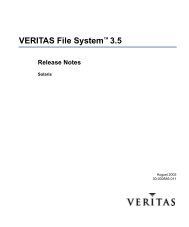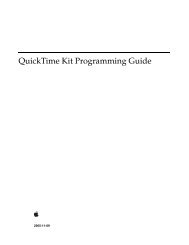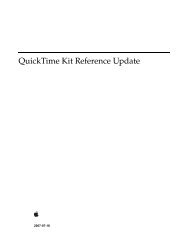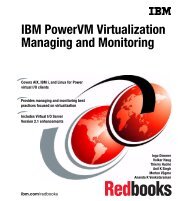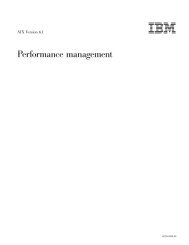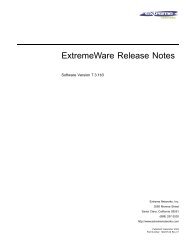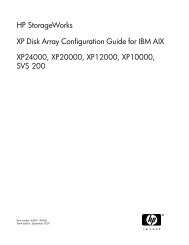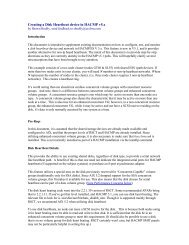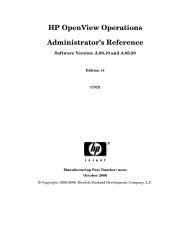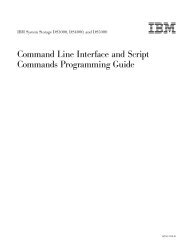HP-UX VxFS tuning and performance - filibeto.org
HP-UX VxFS tuning and performance - filibeto.org
HP-UX VxFS tuning and performance - filibeto.org
You also want an ePaper? Increase the reach of your titles
YUMPU automatically turns print PDFs into web optimized ePapers that Google loves.
Table 4. Intent log flush behavior with <strong>VxFS</strong> 3.5 or above<br />
Operation log delaylog tmplog<br />
Async Write Delayed Delayed Delayed<br />
Sync Write Flushed Flushed Flushed<br />
Read n/a n/a n/a<br />
Sync (fsync()) Flushed Flushed Flushed<br />
File Creation Flushed Delayed Delayed<br />
File Removal Flushed Delayed Delayed<br />
File Timestamp changes Flushed Delayed Delayed<br />
Directory Creation Flushed Delayed Delayed<br />
Directory Removal Flushed Delayed Delayed<br />
Symbolic/Hard Link Creation Flushed Delayed Delayed<br />
File/Directory Renaming Flushed Flushed Delayed<br />
Most transactions that are delayed with the delaylog or tmplog options include file <strong>and</strong> directory<br />
creation, creation of hard links or symbolic links, <strong>and</strong> inode time changes (for example, using<br />
touch(1M) or utime() system call). The major difference between delaylog <strong>and</strong> tmplog is how file<br />
renaming is performed. With the log option, most transactions are flushed to the Intent Log prior to<br />
performing the operation.<br />
Note that using the log mount option has little to no impact on file system <strong>performance</strong> unless there<br />
are large amounts of file create/delete/rename operations. For example, if you are removing a<br />
directory with thous<strong>and</strong>s of files in it, the removal will likely run faster using the delaylog mount option<br />
than the log mount option, since the flushing of the intent log is delayed after each file removal.<br />
Also, using the delaylog mount option has little or no impact on data integrity, since the log level does<br />
not affect the read() or write() system calls. If data integrity is desired, synchronous writes should be<br />
performed as they are guaranteed to survive a system crash regardless of the log level.<br />
The logiosize can be used to increase throughput of the transaction log flush by flushing up to 4 KB at<br />
a time.<br />
The tranflush option causes all metadata updates (such as inodes, bitmaps, etc) to be flushed before<br />
returning from a system call. Using this option will negatively affect <strong>performance</strong> as all metadata<br />
updates will be done synchronously.<br />
noatime<br />
Each time a file is accessed, the access time (atime) is updated. This timestamp is only modified in<br />
memory, <strong>and</strong> periodically flushed to disk by vxfsd. Using noatime has virtually no impact on<br />
<strong>performance</strong>.<br />
nomtime<br />
The nomtime option is only used in cluster file systems to delay updating the Inode modification time.<br />
This option should only be used in a cluster environment when the inode modification timestamp does<br />
not have to be up-to-date.<br />
23



